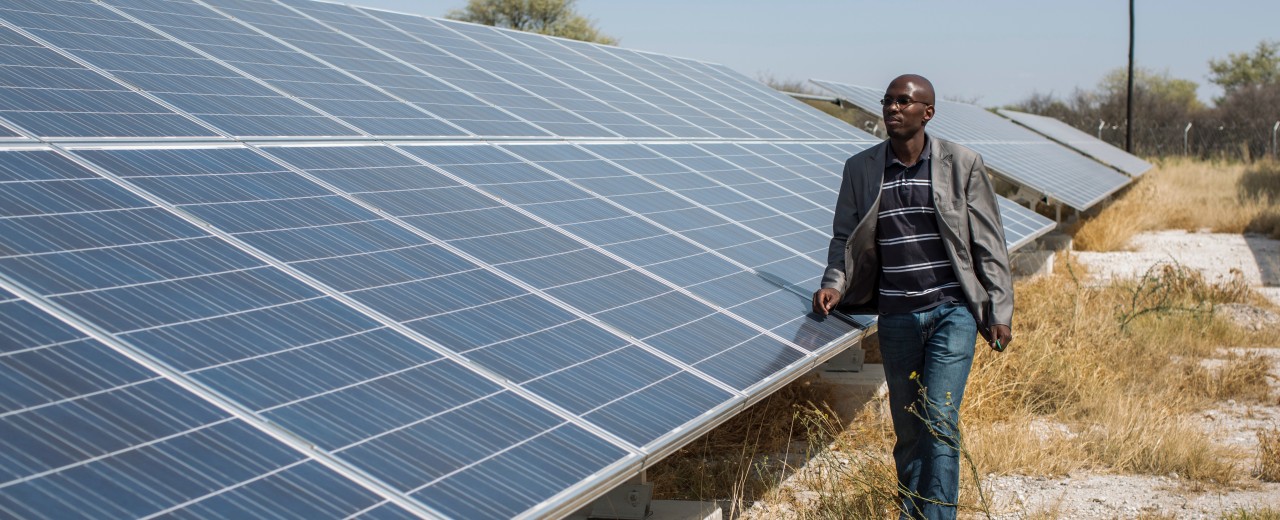Tip: Activate javascript to be able to use all functions of our website
Battery Energy Storage System
Mega battery to facilitate breakthrough for renewables in Namibia
They are clean, inexpensive and can be used almost worldwide: renewable energies offer many advantages. However, they have one major shortcoming: electricity generated by renewables is not always available to the same extent. When the sun shines and the wind blows, the plants often produce more electricity than the power system can take. Contrary to what you might think, too much power is not always a good thing. This is because surplus electricity can destabilise the transmission networks.
By the same token, it is also problematic if the sky is overcast or there is no wind at all. Then the amount of electricity produced takes a nosedive and there is a risk of a lack of sustainably produced energy. In such a case, utility providers are often forced to buy expensive fossil fuels on a short-term basis.
Namibia intends to solve these problems in the future with a “battery energy storage system” (BESS). This will collect the excess electricity produced during the day or which is available at times of low demand, thereby relieving the load on the transmission grids. When demand reaches another peak, the power from the BESS can be made available again – and so supply bottlenecks are avoided.
On behalf of the Federal Ministry for Economic Cooperation and Development (BMZ), KfW has contributed EUR 20 million to the project. KfW will use this amount to cover around 80% of the investment costs incurred in setting up the BESS. The remaining 20% will be provided by the state-owned utility company Namibia Power Corporation (NamPower).
The storage facility will be built at the Omburu substation, an existing grid node in northern Namibia. When the BESS is connected to the grid in early 2026, it will be one of the largest energy storage systems in the entire region with a capacity of 50 megawatt hours.
The construction of the BESS is part of the Namibian government's broader energy policy vision, whereby the country aims to obtain around 70% of its electricity from renewable sources by 2030. This will be made possible by the numerous solar, wind and biomass power plants planned for the coming years. Namibia also intends to reduce its electricity imports to 20% by 2028. This is another area in which KfW is providing support. For example, the financing of a 100-megawatt solar park in southern Namibia was recently agreed. However, there is still a long way to go, as Namibia currently sources up to 70% of its electricity from Zambia, Zimbabwe and South Africa. In South Africa in particular, electricity is mainly generated using climate-damaging coal.
Once Namibia starts producing more of its own green electricity, the benefits of the BESS will definitely become evident as NamPower will then be able to store the excess capacity and return it to the grid if necessary. This will significantly reduce the number of times they have to buy coal-fired electricity from neighbouring countries.
The BESS will also help improve the resilience and stabilisation of transmission grids – an important aspect in the expansion of renewables. This is because the fluctuating energy produced by the sun and wind constantly presents challenges to grid stability. Damage to transmission lines and grid outages are also not uncommon. With the BESS, NamPower will be able to minimise these risks by efficiently managing capacities and thereby compensating for irregularities.
The new storage system will also significantly improve electricity supply reliability in the country. If the battery storage system is fully charged, it will be able to supply around 10,000 households with electricity. NamPower will also be able to ensure some electricity price stability through proper management of the storage system's charging and discharging intervals. This could give international investors a huge incentive to invest in Namibia.
The BESS is designed for a term of 19 years. During this time, the plant will save up to 820,000 tonnes of CO2 emissions. This is roughly equivalent to the amount of carbon dioxide that can be reduced by a solar power plant with an output of 40 megawatts. All this is made possible because the battery system is able to significantly reduce the operating hours of an existing peak load coal-fired power plant. Therefore, with the BESS, Namibia is making a key contribution to climate change mitigation.
Share page
To share the content of this page with your network, click on one of the icons below.
Note on data protection: When you share content, your personal data is transferred to the selected network.
Data protection
Alternatively, you can also copy the short link: https://www.kfw-entwicklungsbank.de/s/enzB3jrm
Copy link Link copied